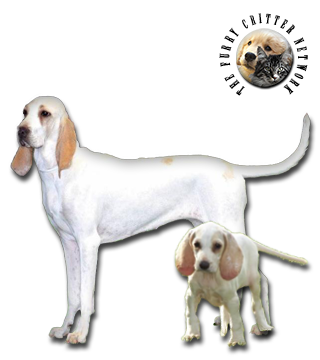Breed Standard
Head: Cleanly cut, finely chiseled, fairly long. Broad skull with rounded occipital peak. Flat forehead with pronounced median furrow and stop. Nosebridge straight at the base and slightly curved at the tip. Well-developed, dark black nose.
Ears: Long, thin, well-curled, pointed at the tip. Must be set on below eye level.
Eyes: Dark.
Body: Long. Neck fairly long and lightly boned. Chest moderately wide, well let-down. Flank raised but full. Hips sloping slightly. Broad, very muscular loin. Broad, straight back.
Tail: Fairly thick at the base, tapering toward the tip, medium in length, never tufted, carried curved slightly inward.
Hair: Lying close to the body, fine, dense, and glossy.
Coat: Bright white with round orange spots never forming a mantle. These spots normally cover black spots on the skin. Orange flecks on the ears are very characteristic of the breed.
Size: Dog: 55 to 58 cm. (21.7-22.8 in).Bitch: 53 to 56 cm. (21-22 in).
Weight: Approx. 28 kg (61.8 lb).
History
The Porcelaine is thought to be a descendant of the English Harrier, some of the smaller Laufhounds of Switzerland, and the now-extinct Montaimboeuf. There have been records of the breed in France since 1845 and in Switzerland since 1880. The breed actually disappeared after the French Revolution (1789–99) but has been reconstructed. Breeders in the UK are attempting to have the Porcelaine accepted as a recognized breed. As of 2009 there have been 14 puppies bred in the UK.
Behavior
Hardy and robust, the Porcelaine is quick, impulsive, and enthusiastic. With his keen nose and resonant voice, he is a hard-driving hunter who works well in a pack. He specializes in small game and is remarkable on hare but also excels on deer and wild boar. Serene and gentle, he is a pleasant companion. He needs a firm owner.
Function
The Porcelaine is a hunting dog usually used to hunt hare, roe deer, and in the north wild boar. The Porcelaines hunt in packs. Being a scent hound, it has a very good sense of smell with which it hunts. The Porcelaine is a fierce hunting dog that has been bred to hunt independently without many orders from the owner. The Porcelaine is also being bred in small numbers in Italy and used to hunt wild boar, however Italian indigenous hounds continue to be the preferred choice of local hunters.
Nothing should keep the Porcelaine from living with his owner. A kennel is recommended for more than one dog in the country. He needs regular brushing and attention to the ears.
Health
Porcelaines have no health issues specific to the breed. Of course, they suffer from general dog issues like any other breed.






